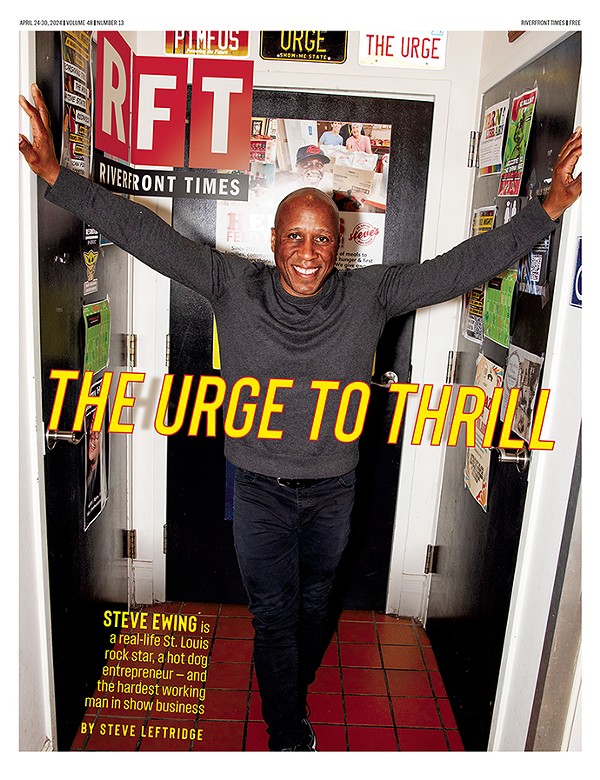"How come white people don't just leave the house when there's a ghost in the house?" Eddie Murphy once sagely inquired, and his curiosity resounds throughout this interminable gobbler. No sooner have scientist Norman Spencer (Ford) and his wife, Claire (Pfeiffer), dropped off Claire's daughter, Caitlin (Katharine Towne), for her first year of college than the placid lakeside house they inherited from Norman's celebrated father starts exhibiting signs of kookiness. First come a few protracted and pointless segments involving the couple's only neighbors, Warren and Mary Feur (Remar and Otto), boho university types who loudly fight and erotically frolic, driving Claire to paranoid distraction. Once we've been corralled through assorted terrors like the digitally enhanced sound of a woman weeping, a scrapbook full of god-awful exposition and an ivy-strewn fence that bites (symbolic, one supposes, of the movie itself), we get down to the hard stuff: The blue gels go up, the polarizing filters come out, the camera hangs in perpetual closeup and the front door starts opening and closing of its own accord.
You read that right, but do try to calm the spasms of icy terror gripping your spine, because it gets much, much worse. As soon as we've been subtly pummeled with tidbits of useful information -- such as exactly where on a nearby bridge the family's emergency cell phone becomes functional, plus Norman's inferiority complex and his mastery of paralyzing narcotics -- the couple's provincial L.L. Bean existence is shattered by loud, random slashes of Alan Silvestri's staccato score, formulated to make the shower scene from Psycho sound like Vaughn Williams' "The Lark Ascending." Oh, and there's this spirulina-splattered wraith chick (Valletta) who starts showing up to say "Boo!" once in a while, especially in the bathroom. If only the movie didn't take a solid hour to move beyond what itinerant Walbiri tribesmen have already gleaned from word-of-mouth of its highly revelatory trailer.
After we've slogged through a few more scenes in which gifted actors are shackled by dialogue so flat it doesn't deserve reprinting (Diana Scarwid as Claire's divorced Wiccan friend, Joe Morton as a kindly therapist), we finally get down to business: The house is haunted, the ghost is a young woman who vanished a year before, and Claire -- despite her husband's protestations -- must unravel the incredibly obvious mystery, before ... I don't know ... it's too late or something. To this end, Zemeckis and screenwriter Clark Gregg wiggle a witchcraft book in our faces, prompt Pfeiffer and Scarwid into a silly bathroom seance and mingle boomer angst with V.C. Andrews-style pulp in the most heinous manner imaginable. Even Woody Allen's attempts to emulate Bergman seem excusable next to Zemeckis' feeble shot at the Polanski creep factor. And the frights are all of the bargain-basement variety; count five beats from just about every periphery-limiting angle and you'll get your bogey.
Of course, Zemeckis is a veteran of three decades of filmmaking, counting fun (Who Framed Roger Rabbit) and fudge (Forrest Gump) among his many accomplishments, so the technical work here is top-notch, from the lensing of DP Don Burgess to the production design of Rick Carter and Jim Teegarden. The problem is, all this labor serves no real purpose. There was no need to build two complete houses and a pier in a Vermont state park, no reason to hide the lame script behind crafty camerawork. Offering a ray of hope is the real unsung hero of the piece, Foley recordist Frank Pepe Merel, whose footfalls -- created by Dennie Thorpe and Jana Vance, mixed by Tony Eckert -- add some desperately needed atmosphere. So hats off to Pepe and company! Give them a raise and a project worthy of their talent!
Seriously, the film's only chord of emotional resonance -- which is strummed ad infinitum on a detuned banjo with a broken fretboard -- is that Pfeiffer's character is unhappy. Well, duh. It doesn't take an alienist to figure out that a boring woman who has given up her promising career as a boring cellist to make boring small talk with her boring husband in their boring house after her boring codependent behavior pushed him to have a boring affair with a boring student is cruising for a violent underwater battle of life and death. The massively superior Ghost Story also featured a dead girl in a lake, but that film gave us Fred Astaire, not merely a moaner who's afraid of stairs.
In many ways, What Lies Beneath isn't even a ghost story or a thriller, just a tale of a relationship gone sour, albeit one with nasty consequences. Considering Claire's limp-wristed approach to her own life, it's pretty hard to sympathize with her as the heroine of the piece, and the lurid stuff between Norman and his fling might as well be called Banal Attraction. So why did this movie get made at all? Good question, and perhaps the only answer is the good old American fear of the libido and the devastating shame that attends it. Somebody is bound to get a kick out of these privileged people destroying each other, but the best thrillers offer us our own hearts, souls and bodies in contorted reflection. Unfortunately, this mirror is totally fogged over.
Opens July 21.





